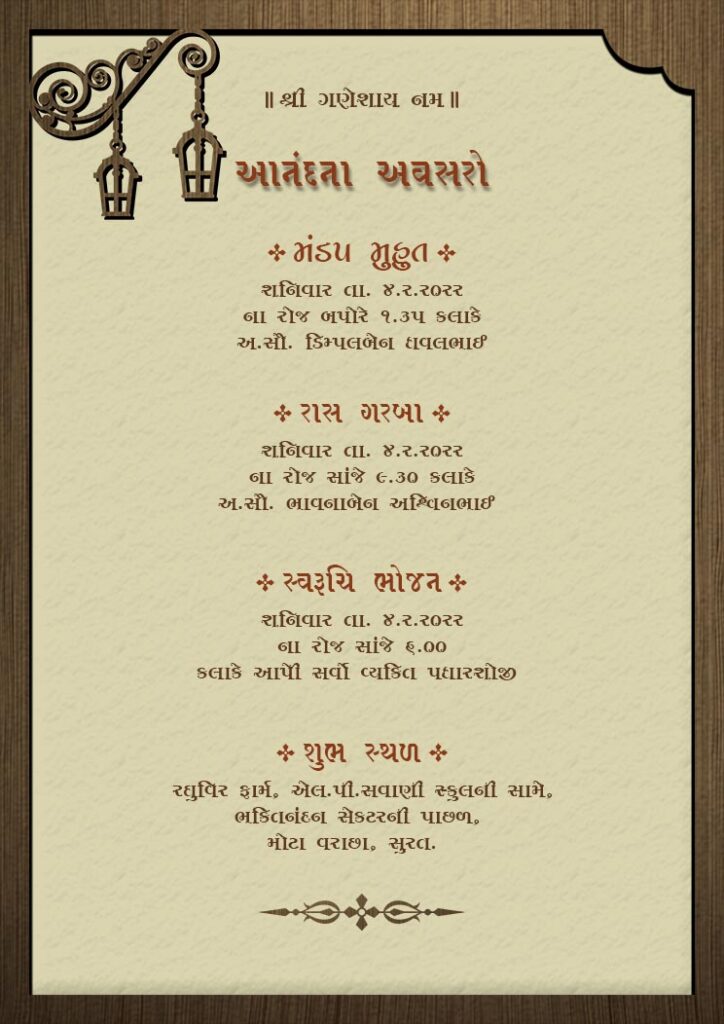When it comes to Kankotri in Gujarati design, tradition and modernity blend seamlessly to create beautiful and meaningful invitations that reflect the rich cultural heritage of Gujarat. This comprehensive guide explores both traditional and modern styles of Kankotri, offering insights into their history, design elements, and how to incorporate contemporary touches while preserving cultural authenticity.
Understanding Kankotri: A Cultural Tradition
Kankotri is a significant cultural artifact in Gujarati communities, particularly during auspicious events like weddings and religious ceremonies. Originating from Gujarat, India, the Kankotri serves as a formal invitation that is not just a mere announcement but a cherished piece of heritage that conveys respect and reverence for tradition.
Historical Significance of Kankotri
The term “Kankotri” is derived from “Kankot,” which means a letter or note in Gujarati. Historically, Kankotri invitations were handwritten on high-quality paper or cloth and adorned with intricate designs and motifs. These invitations were often considered sacred, reflecting the solemnity and importance of the event they represented.

In the past, Kankotris were crafted by skilled artisans who meticulously hand-painted or hand-embroidered designs. This traditional craftsmanship ensured that each Kankotri was unique and carried personal significance for the families involved.
Traditional Kankotri Design Elements
Intricate Patterns and Motifs
Traditional Kankotris are renowned for their intricate patterns and ornate motifs. Commonly used motifs include:
- Peacocks: Symbolizing grace and beauty.
- Lotus Flowers: Representing purity and spiritual awakening.
- Elephants: Signifying strength and wisdom.
These motifs are often incorporated into the borders and backgrounds of the Kankotri, creating a rich visual tapestry that captures the essence of Gujarati artistry.
Use of Vibrant Colors
Traditional Kankotris are characterized by their vibrant color palettes. Colors such as deep reds, rich golds, and lush greens are commonly used, reflecting the festive nature of the events they announce. These colors are not only aesthetically pleasing but also hold symbolic meanings in Gujarati culture.

Calligraphy and Text
The text on traditional Kankotris is usually written in elegant Gujarati calligraphy. The choice of words is carefully selected to convey respect and formality, and the calligraphy itself is often embellished with decorative elements that enhance its visual appeal.
Modern Trends in Kankotri Design
Minimalist Aesthetics
Modern Kankotri designs often embrace a minimalist approach, focusing on clean lines and subtle elegance. This trend reflects a shift towards simplicity and sophistication, moving away from the ornate patterns of traditional designs. Minimalist Kankotris often feature:
- Simple Geometric Patterns: Providing a contemporary touch.
- Monochromatic Schemes: Using shades of a single color for a modern look.
Incorporation of Digital Elements
With the rise of digital technology, modern Kankotris frequently incorporate digital elements such as QR codes for easy RSVP management or links to online event details. This integration makes it convenient for recipients to access information and respond to invitations.
Eco-Friendly Materials
Sustainability has become a significant trend in modern Kankotri design. Many designers now opt for eco-friendly materials such as recycled paper and natural dyes, reflecting a commitment to environmental responsibility while maintaining aesthetic appeal.

Blending Tradition with Modernity
Combining traditional and modern elements in Kankotri design allows for a personalized and unique invitation that respects cultural heritage while embracing contemporary tastes. Here are some ways to achieve this blend:
Hybrid Design Approaches
- Classic Motifs with Modern Layouts: Incorporate traditional motifs into modern, clean layouts to create a balanced design that honors heritage while appealing to contemporary aesthetics.
- Traditional Colors with Minimalist Patterns: Use traditional colors in minimalist designs to bridge the gap between past and present.
Customization and Personalization
Modern Kankotris often feature personalized elements such as family crests or custom illustrations, adding a unique touch that reflects the individual preferences of the families involved. This customization can be achieved through various design techniques, including digital printing and handcrafting.
Choosing the Right Kankotri Design

Consider the Event
The design of the Kankotri should align with the nature of the event. For weddings, elaborate and traditional designs may be more appropriate, while for other occasions, a modern and minimalist approach might be preferred.
Reflect Personal Style
Select a design that reflects the personal style of the hosts. Whether opting for a traditional or modern design, ensure that the Kankotri resonates with the personalities and preferences of the individuals or families involved.
Quality and Presentation
Ensure that the Kankotri is produced using high-quality materials and craftsmanship. The presentation of the Kankotri, including its packaging and delivery, should also be considered to enhance its overall impact.
Conclusion
Kankotri design is a beautiful fusion of tradition and modernity, offering a unique way to celebrate and announce significant events. By understanding both traditional and modern styles, you can create a Kankotri that not only honors cultural heritage but also aligns with contemporary tastes. Whether you choose a traditional design rich in historical motifs or a modern approach with minimalist elegance, the key is to create an invitation that is both meaningful and memorable.
This post was created with our nice and easy submission form. Create your post!





